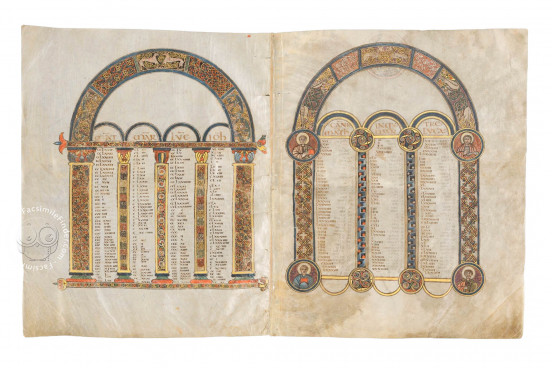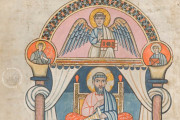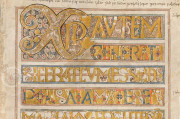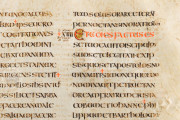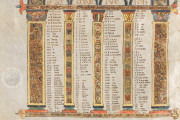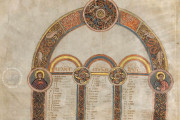This beautiful copy of the Gospels now kept in Stockholm was made in southern England around the middle of the eighth century and is known as the Codex Aureus, or Golden Book. Also called the Canterbury Codex Aureus, nearly every one of its 193 folios is embellished with gilded initials and half of them are dyed a rich purple on which the text of the Gospels is written in gold and white. The glorious Chi-Rho page introducing the Book of Matthew shimmers with gilt lettering and swirling Celtic spirals.
The Codex Aureus contains the Vulgate Latin Gospels written in an exquisite Insular Uncial script. In addition to the Chi-Rho page, its decorative program includes two surviving full-page evangelist portraits and eight pages of canon tables set in decorative colonnades. Once bound in gold, it was stolen by Vikings, bought back by an English lord, and restored to Canterbury. Since its creation over 1,200 years ago, the Codex Aureus of Stockholm remains one of the most magnificent manuscripts of the Middle Ages.
Early English Golden Gospels
Abounding with precious metals, purple-dyed pages, gloriously intricate interlace, and iconic figural painting, the Codex Aureus of Stockholm is the height of manuscript production in southern England.
The magnificent fusion of Insular and Late Antique elements set the standard for the exemplary manuscripts of the later Carolingian empire as seen in its two surviving evangelist portraits.
They are exquisite works that reimagine the Late Antique seated author in bold outline and stylized robes within a temple-like structure hung with curtains. In the image of John, this is infused with delicate Insular triple spirals above the columns.
Lavish Purple Pages with Gold Text
The Codex Aureus of Stockholm is one of the most opulent early medieval manuscripts. Not only are alternating folios dyed purple and written in gold, silver, and white, but the colors are also used to create carmina figurata or figure poems within the text of the Gospels. Within the two columns of text appear crosses, checkerboards, and linear designs.
The script is a majestic Insular Uncial, in which all of the letters are the capital form, and as scriptura continua—without spaces between the words—lending an ancient gravitas to the sacred text. On natural parchment folios, rubrication and additional gold are used for initials and chapter titles.
From Viking Loot to Medieval Treasure
Not long after its completion, the Codex Aureus of Stockholm was looted during a Viking raid certainly for the jeweled gold cover it would have originally had. A ninth-century inscription added on the elaborate Chi-Rho page (fol. 11r) explains how Ealdorman Ælfred and his wife Wærburh purchased the manuscript back from the Vikings for gold.
It was subsequently donated to Christ Church, Canterbury. It is presumed to have remained there until at least the English Reformation, but at some point it was taken to Spain where it came to be owned by Catalina de Haro, Marquise of Heliche. In 1690, it was sold to Swedish linguist Johan Gabriel Sparwenfeldt, who donated it to the Kungliga Biblioteket in 1705.
Binding description
The original binding was certainly covered in gold and jewels, perhaps similar in overall design to the cover of the book held by the symbol of Matthew. This cover was removed and dismantled when it was looted by Viking raiders.
The surviving cover, now separate, is a post-medieval blind tooled full brown leather with a black lozenge design front and back. Fragments of a gilt title remain on the spine with additional black banding.
We have 1 facsimile edition of the manuscript "Stockholm Codex Aureus": The Codex Aureus facsimile edition, published by Rosenkilde and Bagger, 2001-2002
Request Info / Price
